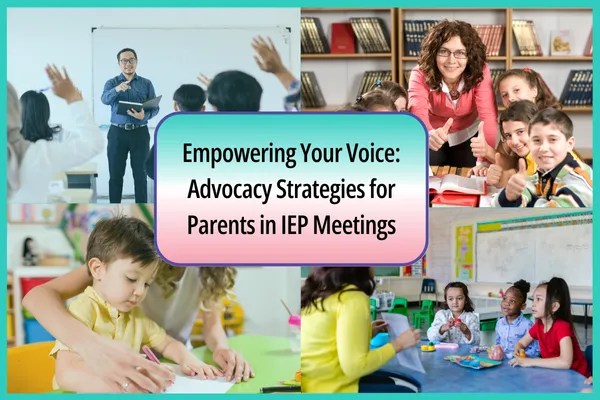
Empowering Your Voice: Advocacy Strategies for Parents in IEP Meetings
Introduction As a parent, you are your child’s most important advocate. When it comes to the Individualized Education Program (IEP), your active participation can make all the difference in ensuring your child receives the support they need. Many parents feel unprepared or overwhelmed by the complexity of IEP meetings—but with the right strategies, you can confidently advocate for your child’s needs. This blog will equip you with tools, mindset shifts, and real-world tips to help you show up powerfully and effectively in any IEP meeting.

Why Your Voice Matters The IEP process is legally designed to be collaborative. Under the Individuals with Disabilities Education Act (IDEA), parents are equal members of the IEP team. You know your child best—their strengths, struggles, and day-to-day behaviors. Your insights fill in the gaps that test scores and classroom observations may miss.
Before the IEP Meeting: Getting Prepared Preparation is one of the most impactful steps you can take. Here’s how to do it:
Know Your Rights: Learn the basics of IDEA, Section 504, and your state’s special education laws.
Gather Evidence: Keep a binder of your child’s schoolwork, report cards, evaluations, and any notes from teachers or therapists.
Review the Current IEP: If this is not your first IEP meeting, go through the previous plan. Identify what worked and what didn’t.
Request Drafts Early: Ask the school to send the draft IEP a few days before the meeting. Read it thoroughly and note your concerns.
List Your Goals: Write down 3–5 specific goals or concerns you want addressed.
During the Meeting: Advocating with Confidence The IEP meeting can feel intimidating, but remember—you belong at the table.
Stay Focused: Use your notes and stick to your priorities.
Be Assertive and Respectful: You don’t have to agree with everything. Ask questions and share your perspective calmly.
Use Examples: Describe specific situations or patterns you see at home. These can support requests for services or changes.
Take Notes or Record: With prior permission, record the meeting or jot down key points and action steps.
Bring a Support Person: Another set of ears can help you feel more supported and catch details you might miss.

If You Disagree: What to Do Next Disagreements can arise. Here are respectful ways to address them:
Request Clarification: Sometimes misunderstandings can be resolved with more information.
Ask for Additional Data: Request further assessments or classroom data.
Submit a Parent Statement: Ask to include your written concerns in the IEP.
Use Formal Dispute Options: If needed, consider mediation, filing a complaint, or requesting a due process hearing.
Advocacy Tools and Resources
PTIs (Parent Training and Information Centers) – Local resources to help you learn and connect.
Facebook Groups and Online Communities – Find others on the same journey.
Encouragement for the Journey IEP advocacy is not a one-time event—it’s an ongoing journey. Each meeting builds on the last. As you gain experience, you’ll grow in confidence and skill. Know that showing up, speaking out, and staying engaged are already powerful acts of advocacy.
Check my course: THE ENLIGHTENED IEP COURSE
Conclusion Advocating for your child’s education is one of the most meaningful roles you can play. By preparing thoroughly, speaking up with confidence, and building strong partnerships with the IEP team, you help create a learning environment where your child can truly thrive. Your voice matters more than you may realize—keep using it with love, persistence, and purpose.

